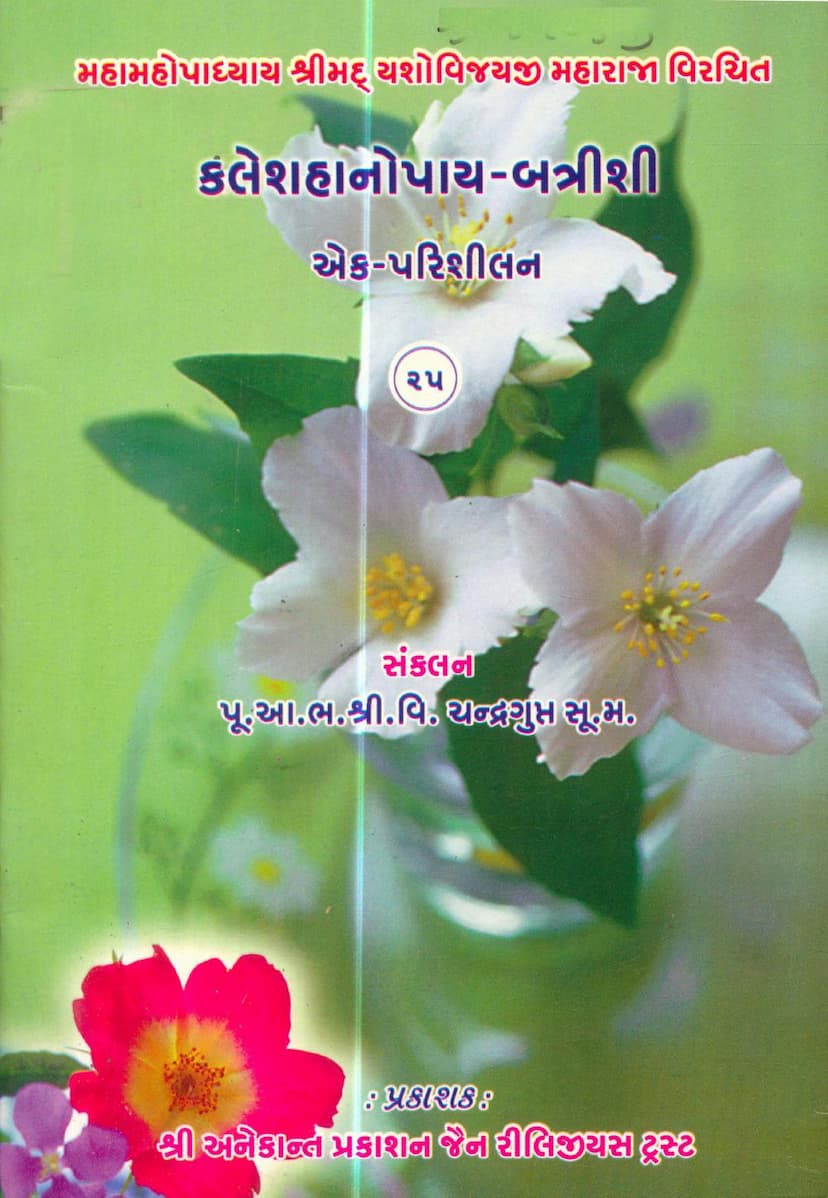Kleshhanopay Batrishi Ek Parishilan
Added to library: September 2, 2025

Summary
Here's a comprehensive summary of the Jain text "Kleshhanopay Batrishi Ek Parishilan" by Chandraguptasuri, based on the provided pages:
This document is a detailed analysis and commentary ("Parishilan") on the "Kleshhanopay Batrishi" (Thirty-two verses on the means of eradicating afflictions) by the great scholar and yogi Mahamahopadhyaya Shrimad Yashovijayji Maharaj. The commentary is presented by Acharya Shri Chandraguptasuri, a disciple of Acharya Shri Amaragumasuri, who is a disciple of Acharya Shri Atichandrasuri, who is the disciple of the illustrious Acharya Shri Ramachandrasuri. The publication is by Shri Anekant Prakashan Jain Religious Trust, with financial support from a pious family from Pune.
The text begins by emphasizing that the ultimate goal of Jainism is the eradication of suffering (Kleshas) in this cycle of birth and death. It highlights that all philosophical systems, including those outside Jainism, identify Kleshas as the root of worldly existence. However, the author asserts that these other systems fail to accurately describe the true nature of Kleshas.
The commentary focuses on dissecting the Kleshhanopay Batrishi, which systematically refutes the views of other philosophical schools regarding the means of overcoming Kleshas and then establishes the Jain perspective.
Key Aspects of the Commentary:
-
Refutation of Other Philosophies: The primary aim of this "Batrishi" and its commentary is to systematically dismantle the arguments and methodologies proposed by other Indian philosophical schools for the eradication of Kleshas.
- Buddhism: The commentary extensively tackles the Buddhist view that the absence of self (Nairatmya Darshan) is the means to eliminate Kleshas. It critiques the Buddhist notion that attachment arises from the perception of "I" and "mine," which leads to suffering. The text argues against the Buddhist concept of anatta (no-self) and anatman (non-self), pointing out logical inconsistencies. For instance, it questions how one can have a perception of "no-self" if there is no self to perceive. The commentary challenges the Buddhist idea that craving (trishna) is the cause of birth and that its eradication leads to liberation.
- Samkhya and Patanjala: The commentary then addresses the Samkhya and Patanjala schools. It discusses the Samkhya concept of "Vivek Khyati" (discriminative discernment) as the means to overcome Kleshas, particularly ignorance (avidya). The text details the seven stages of "Praptabhuprajna" (enlightened wisdom) as described in Patanjali's Yoga Sutras, which are categorized into four types of "Karyavimukti" (liberation of action) and three types of "Chittavimukti" (liberation of consciousness). It explains the five Kleshas (Avidya, Asmita, Raga, Dvesha, Abhinivesha) and their various states (prasupta, tanu, vichchinna, udara). However, the commentary then points out flaws in the Samkhya/Patanjala philosophy, such as the concept of a completely unchanging Purusha and the resulting contradiction in attributing real causation or bondage to it.
- Nyaya and other Logicians: The text also addresses the views of the Nyaya and other logical schools. It explains their belief that liberation is the cessation of suffering (Klesha) and that this is achieved through knowledge, particularly the understanding of reality. The commentary questions their assertion that one must generate suffering to achieve ultimate liberation, labeling this as a flawed and arrogant notion. It refutes the idea that "finality" of suffering is comprehensible and therefore a definable goal for its eradication.
-
Jain Philosophy and its Superiority: After refuting other schools, the text implicitly (and sometimes explicitly) emphasizes the Jain perspective:
- Knowledge and Right Conduct: The foundational principle for eradicating Kleshas in Jainism is presented as the combination of "Samyak Jnana" (right knowledge) and "Samyak Anushthana" (right conduct). The commentary emphasizes that knowledge alone is insufficient without action, and action without knowledge is also ineffective, illustrating this with an analogy of a blind man and a lame man working together.
- Nature of Kleshas: Jainism views Kleshas as karmic attachments (karmarupa) that lead to rebirth. These are not merely psychological states but are deeply intertwined with the karmic influx that obscures the soul's true nature.
- Karma and Liberation: The text highlights that the shedding of these karmic Kleshas is achieved through a combination of right knowledge, contemplation, and diligent practice (Yoga, in the broader Jain sense, which includes austerities and moral discipline). The goal is not just to remove suffering but to attain the state of infinite bliss and omniscience.
- Critique of "Enjoyment" for Karma Extermination: The commentary refutes the idea that certain actions (like undergoing suffering) are necessary for the exhaustion of karma. It argues that this leads to an endless cycle ("anavastha") of action and consequence, and the Jain path of "Yoga" (knowledge and practice) is the true means of karma annihilation.
- Nirupama Karma: The text distinguishes between karma that can be modified or destroyed through effort (yoga) and "nirupama" (unalterable) karma, the destruction of which is achieved through experiencing it (bhoga). However, it emphasizes that the primary path to liberation from Kleshas is through the diligent practice of yoga.
- The Ultimate Goal: The ultimate goal, achieved through the complete eradication of Kleshas and karma, is the "Nirupama Sthan" (unsurpassable state), which is described as eternal bliss, free from the cycle of birth and death ("Bhavaprapancharahitam, Paramanandam Meduram").
In essence, "Kleshhanopay Batrishi Ek Parishilan" serves as a rigorous philosophical treatise that deconstructs the efficacy of various non-Jain paths to liberation, ultimately advocating for the Jain path, which is characterized by the integrated practice of right knowledge and right conduct as the sole means to overcome Kleshas and attain ultimate bliss. The commentary is meticulously detailed, engaging with specific arguments from other schools and offering reasoned counter-arguments grounded in Jain philosophy.